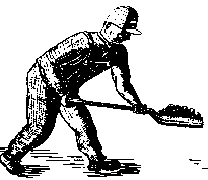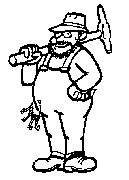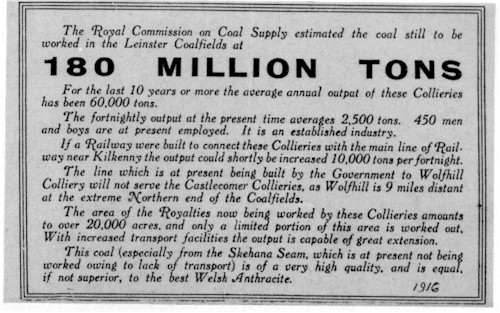![]()
|
The Deerpark Train |
|||
|
|
|
|
|
|
First Train to Castlecomer
Jan 21st. 1921. A steam-train ran from the
Deerpark Mines to Kilkenny. The coal traveled to all parts of the world via this train. The
train is long gone now but we went on a field trip to trace it’s route in Castlecomer and we discovered many
interesting facts about it. ·
Facts ·
Gates In 1832 a civil and mining
engineer called David
Aher drew up
plans for the first Dublin to Kilkenny railway which was the Leinster
and Munster railway. It was to run between the Barrow river and the
Castlecomer plateau with a branch line to Carlow. In
1918 the British war office gave help towards the building of the Castlecomer
railway to the proposed Deerpark Colliery. They
thought at this time that to be able to get coal quickly from the mines would
be very important in times of war. The track was originally intended to run
on past the Deerpark mine up to another local
industry “The Fireclay Factory” situated at “The Swan” in County Laois. This
part of the track, however was never constructed. The coal was loaded on to the train at the Deerpark mine and traveled from
there to Kilkenny - on to Dublin and from Dublin to all parts of the world. Coal from
other local mines- “The Rock”, “The
Vera” and the “Skehana” pits was ferried to the the
Deerpark by aerial ropeways similar to those seen
on the ski slopes. The coal was carried across the hills in large buckets on
these strong steel ropes. At peak production in the 1950’s, trains carried 300 tons a day to a depot at Kilkenny station close to the present hardware store called “Chadwicks”. Each train carried about 100 tons. This would be loaded on from 10 to 15 carriages. The various products were: - ·
Cobbles, ·
Aga nuts, ·
Peas, ·
Beans, ·
Breakage, ·
Culm ·
Cannels (pronounced ‘ kennels’). Constructing a train track
is a very difficult job. We never thought much about it until we went on a trip to trace the
route of the old Deerpark train. We traced the
route from Dysart Bridge, just outside Castlecomer as far as the Deerpark mine. This was a distance of about two miles.
The work involved was amazing, even more so when you think that it was back
in the 1920’s when equipment was pretty primitive. Much of the work was done
by hand. There were no Hymacs, JCB’s, Jack hammers
etc. in those days. The pick & shovel were the main tools. At Dysart Bridge we saw the first difficulty encountered
by the workers. Large concrete pillars were constructed in the river bed to
hold the steel bridge for the train to pass over the rivers “Deen” and “Dinan”. However, the
first big flood that came swept the whole “shebang” (local word for
everything) away and higher pillars had then to be constructed. Train tracks, as far as possible are laid on level ground
as climbing and descending
can be both difficult and dangerous, particularly in frosty
weather. Sometimes it is necessary to build large mounds of earth across land
in order to keep the track level. Other times it is necessary to cut into
hills for the same reason. When a bridge is constructed, needless to say, a
mound of earth has to be put in place to allow the train to make a gradual
rise to the required height. We saw several examples of these “mounds” and “hill
cuts”. The amount of earth that had to be moved was unbelievable. We imagined
hundreds of men and boys with picks and shovels and horses and carts moving
the earth. We wondered how difficult it was, how many people were employed,
how many cart loads of earth were moved and indeed how they managed to make
the tracks so level and solid enough to allow the heavy trains to run over
them. Some of the earth could be dug out of a hill and dropped in a valley
close by but we are sure that much of the earth for building the mounds had
to be brought from far away. |
|||
|
|
|
||
|
Having Fun under the Bridge |
|||
|
Every time the track met a stream a small bridge had to
be made. There are plenty of these bridges in our locality. They were very
well made with mass concrete and we had great fun walking in under a few of
them. We had to bend down to walk the short distance through them. This was
interesting because that was the way the miners had to travel underground to
their place of work- bent down-and they often had to walk two miles like
this. We tried it for 20 meters under the bridges and our backs were broken
by the time we came out the other side. A local miner told us –jokingly- that
when traveling to work underground you would be better off with a broken back
because then you would be bent over perfectly for walking under low roofs. When the route was ready the next stage was actually laying the “Tracks”. The heavy iron rails were bolted down on large wooden “sleepers”. This was a very skilled and heavy job. The sleepers were about 2m x 30cm x 15cm, usually made from oak and were laid about 50cms apart. They had to be laid perfectly level otherwise the track would be uneven. The sleepers were very heavy and after the closure of the track were in great demand by farmers and other people who found many uses for them. It was a great skill (though very dangerous and your mother would not want to know you were doing it) to be able to run at full speed along the track stepping from sleeper to sleeper without breaking your neck. Making the sleepers of course was another “spin-off” industry of making the track. Fencing the track and making gates was another big job that had to be done. |
|||
|
|
|
||
|
Two of the many gates along the track |
The Shamrock Logo stamped on each gate |
||
|
(Top of
Page) It was about fourteen miles from Kilkenny to the Deerpark mines. The train track ran through farmers fields. All of the track had to be fenced off so that animals would not wander on to the track and get killed or cause accidents. The farmer needed to pass from field to field so gates had to be erected in most fields. You can imagine how many gates and how many pillars and yards of wire were needed to complete that job. The Blacksmiths would have been very busy making the gates and pillars. The iron gates were very well made and many are still in use today. They all had a little shamrock design punched into them. At each gate there was a notice stating that there would be a severe fine imposed on anybody that left a gate open.
(Top of
Page) The Train was run on coal. The fireman had to keep shoveling coal into the furnace which generated the steam to propel the train. Like any fire, there was a buildup of "clinkers" (molten rock & burned coal). The clinkers were simply removed from the fire and thrown off the train on to the track. The track is still covered in clinkers. You can find them everywhere. We collected a few large ones for our museum. (Top of
Page) Our Teachers have some great memories of the Railway Track in their youth. It was a great place to play, so long as your mother did not know what you were up to. Down at Dysart Bridge, the entrance to the town from the Kilkenny side, the water was fairly shallow under the bridge. You could play and hide under the bridges and do some great splashing. In Winter time, if you were skilled, you could catch a trout or two as they jumped up on the steps on their way to spawn in the upper reaches of the river. If you were really skilled and fast you might be lucky enough on a rare occasion to capture a Salmon. All this of course was illegal as the fish were heading for their spawning grounds but young boys were not to know this and the thrill of arriving home with the "dinner" was something to be remembered. The next place of play was the Wooden bridge that crossed the track at the Parish Priests' house. This was known as the "Canons Walk" and was a short cut for the Priest to the Church. There was a "Swastika" (German - Natzi Emblem) attached to one of the pillars of the bridge and this made this area very exciting indeed. Many tried and failed to remove this emblem but somebody did succeed as it is no longer there. This was a safe place for "Cowboys & Indians" to ambush the train. If the train let out a whistle or a gush of smoke from it's chimney as it passed under, it really made your day. The nearby woods and high banks added to play possibilities in this area. The next spot was the area around the Prince Grounds (GAA Pitch). Here you had a double bridge, high banks with plenty of bushes and trees on the slopes, cuts into the hillside which resembled the "canyons" in the Wild West. You then traveled out to the "Sandy Banks" a popular swimming area. The possibilities for all sorts of games in this area were endless. It was a great skill to put your ear to the track and predict that the train had just left the "Park" yard (about a mile away) and would be along in about five minutes. "These were the real Indians" Young "Entrepreneurs" had a field day on the train track. The Lord turned water into wine but the 'Comer lads could turn "halfpennies" into "Pennies" and so gain a 100% profit on their savings in an afternoon. This was done by laying out the halfpennies on the track. When the train passed over them it squashed them and made them look like the larger coins -"Pennies". These were later passed off in the shops as "Real Pennies". This was a great act of "Bravado" but on reflection we think the kind shopkeepers were wise to the tricks but played along and rewarded the youngsters for their cleverness. The last foolish "game" that was "played" on the train track by some boys that seriously lacked in brain cells was "DARE". The dare was to put your hands on the track as the train approached and to see who would leave them on the longest. If an adult caught you attempting this - you would get a good hammering which would not be appreciated at the time but in later years would be looked on with thanks. This foolishness stopped in Castlecomer when a report on the paper told of the tragic circumstances in another part of the country where two unfortunate boys playing the same game lost their Hands !! |
|||
|
|
|||
·
Background to Transportation (Click to
view)
· Station Masters House & Interview with Mr. Seamus Farrell (Click to view)
· Tracing the Track through Castlecomer








